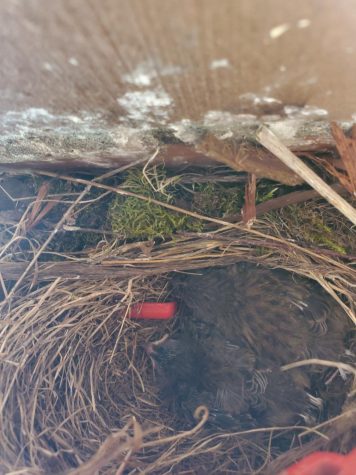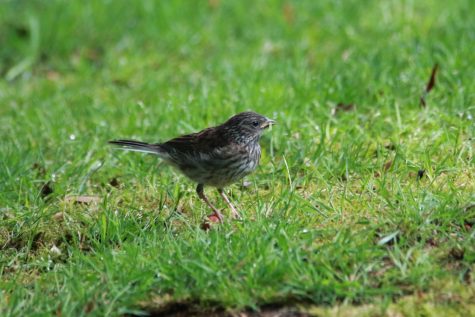A Fire Drill Killed a Baby Bird. Here’s What We Can Do Better.
On the early morning of May 4th, the chicks were alive and well. But at 10:45, there was a fire drill.
On May 1st, Sophie B. ’24 reported hearing baby birds near the front of St. Nick’s. The day after, I confirmed the presence of two late-stage nestling juncos in a nest right at the front entrance.
Their nest was inside the fire alarm bell. I immediately alerted the administration and put up signs to divert students to a different entrance, hoping that would be enough to keep the nestlings safe.

On the early morning of May 4th, the chicks were alive and well. But at 10:45, there was a fire drill. Minutes after the bells first rang, Halle F. ’23 found the chicks on the ground in front of St. Nick’s. One was below the nest, the other a few feet away. An hour later, one chick had disappeared into impenetrable shrubbery alongside the building and the other had died, twitching from likely brain damage.
The chicks had stubby tails but well-developed feathers. One of them could run, even hop a little in the air when flapping. Given a few days, even hours, they would have ventured out of the nest themselves.
It is a blessing and a curse to know that this situation was not easily preventable. Active nests are strictly protected by the Migratory Bird Treaty Act of 1918, and state law requires that fire drills be conducted as “coordinated with the fire department,” explains Mr. de Grys. The particular alarm is connected to the St. Nick’s system, so it couldn’t be deactivated. “We were ethically bound,” said Mr. de Grys, in terms of balancing student and wildlife wellbeing, “[but] also legally bound.”
I don’t fault Lakeside, since they had their hands tied. Going forward, though, I believe that our community could take steps to prevent situations like this from happening again.
Importantly, don’t try to “rescue” baby birds. Rescuing baby birds without an expert present is generally discouraged: along with risk of catching germs or injuring the chicks, there’s the danger of unnecessarily moving chicks that are naturally outside of their nest, being supervised by unseen parents. However, there are other steps we can take.
An immediate solution is for Lakeside to install anti-nesting measures on the alarms. There are already many outdoor fire alarms with cages around them, and anti-nesting spikes or even mirrors — which confuse potential nesters — are alternative solutions. Another option would be to create a student group to monitor these alarms in early spring and hire nest removal services, though for something as important as a fire alarm system, the school should be responsible.
There is a more drastic option: applying for a US Fish and Wildlife Service permit to destroy the nest, which may be issued “when the particular nest is causing a human health or safety concern or the birds are in immediate danger,” both of which are true in an alarm-nesting situation. There’s no law against destroying empty nests to discourage future nesting.
Beyond nests, there are other areas where Lakeside could take initiative. Several large windows around campus have caused at least three bird deaths just this year. Installing stickers or making a student art project for artistic window decals is an idea that Bird Club has floated and is drafting a curriculum idea for, an approach that could be adopted beyond Pigott’s front window.
There are steps individual students can take as well.
Earlier this year, we lost a fledgling when a student walked too close to a panicked chick, causing it to flee. They didn’t notice the baby bird nor the parents attempting to chase them away and accidentally routed the fledgling into the ivies next to St. Nick’s, where it would be unrecoverable.
I understand that it’s often difficult to think about anything other than your next class during passing periods. Still, it’s hard to reconcile that understanding with the reality that out of the two baby birds displaced that day, one died due to systemic inevitability, and the other may have been killed by a Lakesider’s obliviousness.

The previous day, too, I observed several students walking through the front doors of St. Nick’s even after I had put up the signs imploring passers-by to use the north entrance, away from the alarm bell.
I’m not asking everyone to commit to what I did: to skip class and sprint around campus spreading an alarm, to become a birder, to join a conservation organization, to sob in the main office over a single dead baby bird. I understand that not noticing birds is normal. I’m just asking Lakesiders to start looking, to tackle this awareness problem and notice the world around them, especially when the world is screaming for help on the ground or fluttering wings in their faces. Students looking to do more should go ahead and join that conservation group or Audubon Society, or put out nesting bird food! As Mr. de Grys says, “educate yourself and learn more, think about ways to keep your school and home bird-friendly…!”
Our administration has done a bang-up job of keeping greenery alive on campus, from landscaping with native plants to keeping the ravine mostly wild. Plenty of community members came to guard the chicks following the fire drill, a veritable crowd cheering efforts to save them. Ian S. ’25 even committed to driving the chick to a wildlife rescue before the news broke of its death. Faculty and students in the days since have voiced their apologies, sympathy, and sadness. For that, I have the utmost appreciation for our community.
In the end, life goes on. Recently, I’ve seen a juvenile junco around St. Nick’s, being corralled and fed by patient parents. Maybe that’s our second chick. I like to think it made it.
The corpse is gone now. Long gone. Disappeared by lunch time, likely eaten by a crow. I’m glad about that — everyone needs to eat, and better that corpse go back into the ecosystem than inaccessible underground. But what shouldn’t disappear is our memory of the loss and the knowledge that there’s work to be done to prevent this from happening again.
You can take the woman out of the bird, but you can't take the bird out of the woman: meet Yoon Lee.
